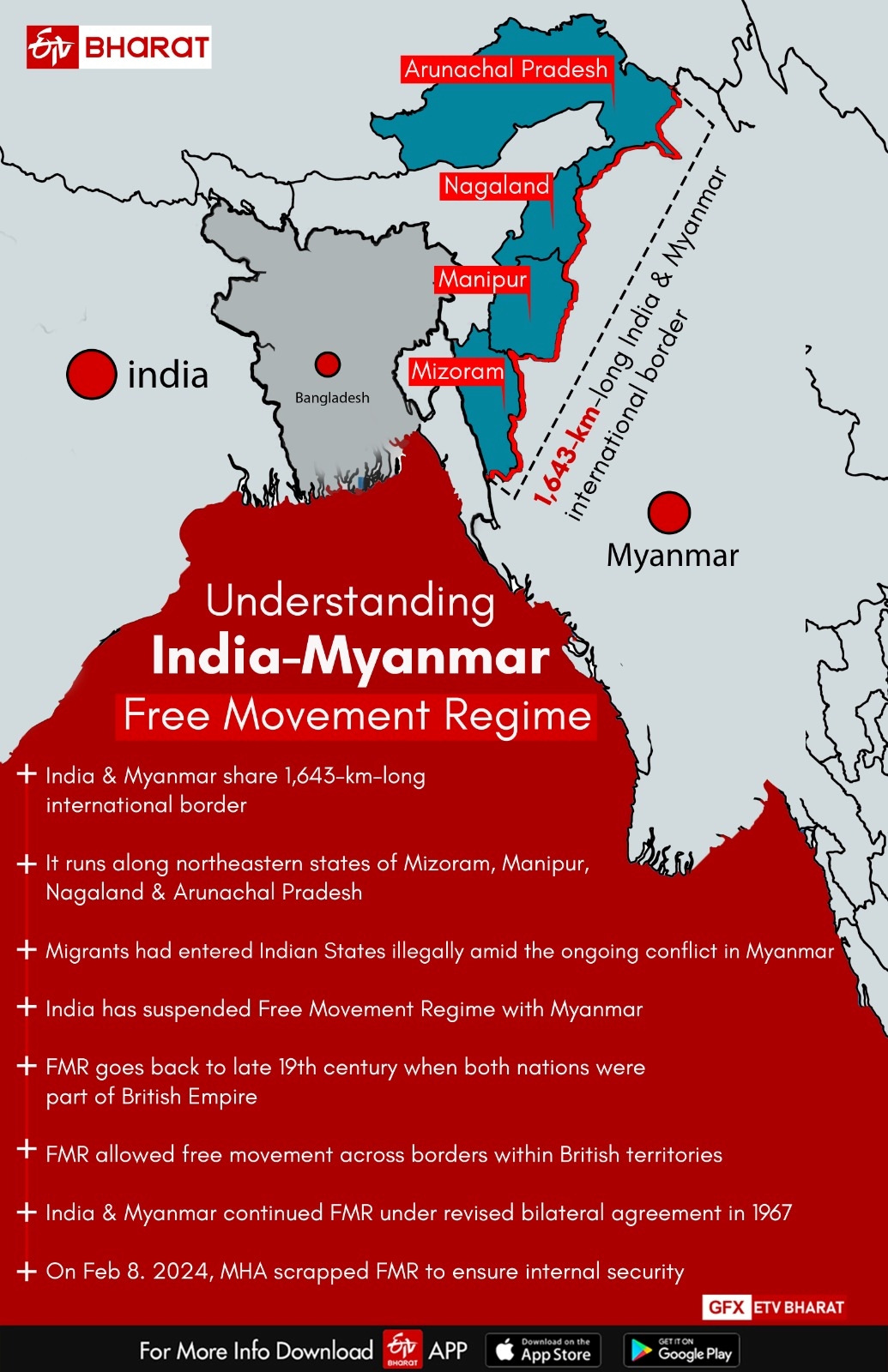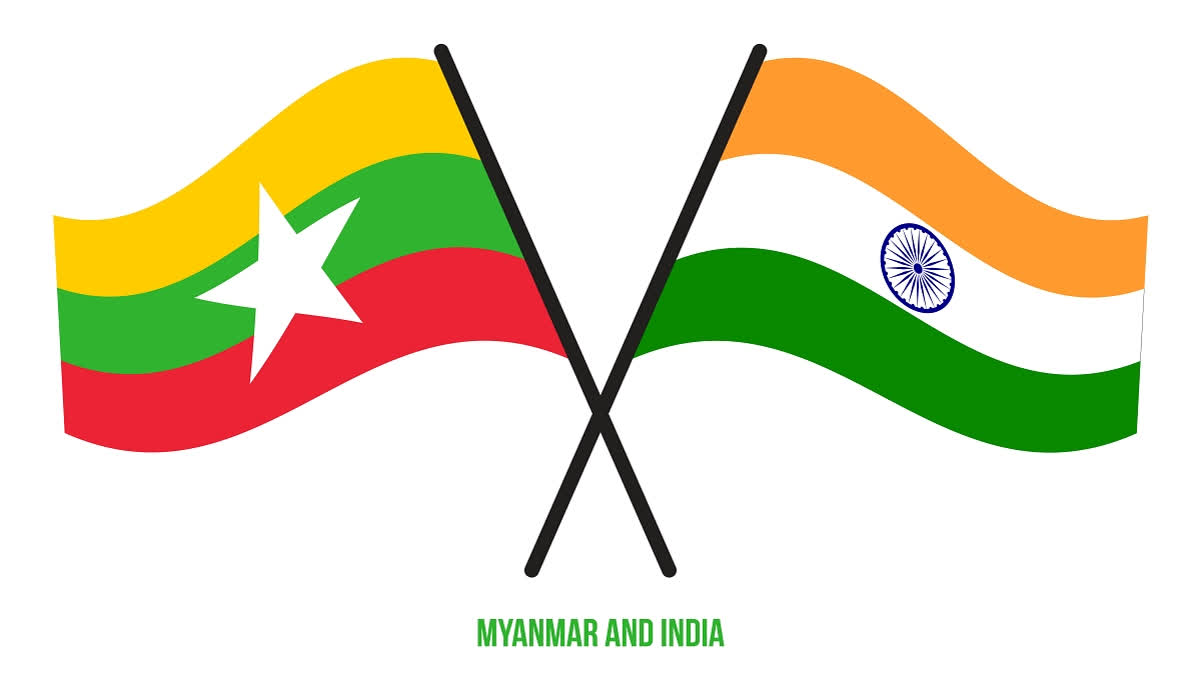New Delhi: The unique location of the house of the Angh (chief) of Longwa village in Nagaland's Mon district has been widely reported in the media. Half of the house is in India and the other half is in Myanmar. While the kitchen is in Myanmar, the bedroom is in India. In other words, the family members eat in Myanmar and sleep in India.
Similarly, during Sunday mass in the church of Longwa, half of the congregation sits in India and the other half in Myanmar. The Angh's house and the church in Longwa are just examples of why the people of the village believe that the international boundary between India and Myanmar is just imaginary. And it is not just at Longwa. A similar belief runs among people in other northeastern states too which border Myanmar. There are communities and families who live on both sides of the border.
India and Myanmar share a 1,643-km-long international border that runs along the northeastern states of Mizoram, Manipur, Nagaland and Arunachal Pradesh. Given the interdependence among people on both sides of the border, they were allowed to cross over to each other's countries without a visa for specific periods of time by the governments of both India and Myanmar. However, this system was formalised in 2018 when India and Myanmar signed the Free Movement Regime (FMR) agreement.

However, New Delhi's decision to suspend the FMR in view of the ongoing conflict between ethnic armed organisations and the military junta in Myanmar has sparked a huge debate.
So, what is the genesis of the FMR?
The roots of this regime go back to the late 19th century when both nations were part of the British Empire. The regulation allowed free movement across borders within British territories. After independence in 1947 (India) and 1948 (Myanmar), the two countries continued the arrangement under a revised bilateral agreement in 1967.
However, India and Myanmar established the FMR in 2018 as part of New Delhi's Act East Policy promoting cross-border movement of people up to 16 km without a visa. Those traveling beyond the 16 km zone require a valid passport and other immigration formalities. The FMR facilitates easier movement and interactions for people residing in the border areas of both nations, allowing them to meet relatives and carry out economic activities.
Individuals residing at the border need a one-year border pass for staying in the neighbouring country. It aimed to facilitate local border trade, improve access to education and healthcare for border residents, and strengthen diplomatic ties. Indian citizens can stay up to 72 hours in the 16 km zone inside Myanmar without any formalities. For Myanmar citizens, the limit is 14 days inside the 16 km zone in India.
People in Mizoram and Nagaland especially benefited from the FMR arrangement. The Chin people of Myanmar and the Kuki people of India and Bangladesh are the kindred tribes of Mizos and many of the Mizo migrants in Myanmar have accepted the Chin identity. All of them come under the broader Zo community. In Nagaland, people mainly of the Khiamniungan and Konyak tribes live on both sides of the border.
As such, when the Government of India announced the suspension of the FMR last month and the decision to erect a fence along the India-Myanmar border, it was met with fierce opposition by the people and state governments of both Mizoram and Nagaland. On the other hand, the Meitei majority people of Manipur and the state government of Manipur as well as the state government of Arunachal Pradesh have welcomed the move.
So, why has the Government of India suspended the FMR?
On February 8, Ministry of Home Affairs (MHA) announced that it has decided to scrap the FMR between India and Myanmar to ensure the internal security of the country and to maintain the demographic structure of India's northeastern states bordering Myanmar.
"It is Prime Minister Shri Narendra Modi Ji's resolve to secure our borders, the Ministry of Home Affairs (MHA) has decided that the Free Movement Regime (FMR) between India and Myanmar be scrapped to ensure the internal security of the country and to maintain the demographic structure of India's North Eastern States bordering Myanmar," Home Minister Amit Shah posted on X, formerly known as Twitter.
"Since the Ministry of External Affairs is currently in the process of scrapping it, MHA has recommended the immediate suspension of the FMR."
Manipur especially has borne the brunt of the negative fallout of the FMR. Following the coup d'etat in Myanmar in 2021 and the subsequent conflict between the ethnic armed organisations and the military junta, there has been a rise in influx of illegal immigrants, particularly the Chin, and Kuki communities from Myanmar, potentially straining resources and impacting local demographics.
Manipur shares a 398-km-long border with Myanmar. It is a porous border enabling illegal drug trade. The Manipur government had declared a 'War on Drugs' to curtail this. This war was targeted against the Golden Triangle comprising the drug cartels of Myanmar, Laos and Thailand. This cartel has forayed into Manipur making it in fact a source of drugs.
Over the last five years, poppy cultivation in Manipur had spread to 15,400 acres of land in the hills. In a letter to Manipur Home Commissioner in May 2023, Superintendent of Police (NAB) K. Meghachandra Singh said that 2,518 people have been arrested during this period under the Narcotic Drug and Psychotropic Substances (NDPS) Act.
The FMR has also been misused by insurgent groups operating in northeastern India, allowing them to cross the border easily and evade capture. Several insurgent groups from India's northeast region have established camps and taken refuge in the remote border areas of Myanmar's Sagaing Division, Kachin State, and Chin State. These groups include the United National Liberation Front (UNLF), People's Liberation Army (PLA), the United Liberation Front of Assam (ULFA), National Socialist Council of Nagaland (NSCN), and smaller outfits such as Kuki and Zomi insurgents.
The porous nature of the India-Myanmar border and the FMR that allows unrestricted cross-border movement up to 16 km have facilitated these groups' activities. They have used the areas across the border as safe havens, obtained arms and ammunition, trained cadres, and, more alarmingly, engaged in illicit activities like drug trafficking and arms smuggling to fund their operations.
The misuse of the FMR by these insurgent outfits and the lack of effective border management have contributed to the flourishing of illegal cross-border activities, particularly drug trafficking, across the unfenced borders between the two countries. This is evident from the data released by the Manipur Chief Minister's Office, which shows that in 2022 alone, 500 cases were registered, and 625 individuals were arrested under the Narcotic Drugs and Psychotropic Substances (NDPS) Act in the state.
Consequently, there is a pressing need for both India and Myanmar to collaborate closely and implement robust measures to strengthen the administration and surveillance of their shared border regions. Such efforts are crucial to curb the menace of drug trafficking, unauthorised cross-border movement, and the activities of insurgent groups that threaten the security and stability of the region.
It is against this background that the ethnic conflict erupted in Manipur on May 3 last year after the state's High Court recommended that the demand of the Meiteis for Scheduled ST status be considered. While the Meiteis form the majority population in the state and mainly live in the Imphal valley, the Kuki-Zomis and the Nagas living in the hills enjoy ST status.
While the Kukis claim that giving ST status will give Meiteis the right to buy land in the hills, the Meiteis say that the conflict is a result of retaliation by the Kukis against the government’s crackdown on drug smuggling from across the border from Myanmar and poppy cultivation in the hills of the state.
Now, with the suspension of the FMR, Manipur has started deporting the Myanmar nationals alleged to have entered illegally. Last Friday, the first batch of seven individuals was deported from state capital Imphal.
"Although India is not a signatory to the 1951 Refugee Convention, it has given shelter and aid to those fleeing the crisis in Myanmar on humanitarian grounds with a systematic approach," Manipur Chief Minister N. Biren Singh said during an interaction with the media.
"The number is huge, so we cannot deport them altogether at one time. So part by part, we are deporting, and there are some legal procedures that we have to follow; we are following them and are deporting them & will continue to deport."
So, why has the suspension of the FMR been opposed in Mizoram and Nagaland?
Unlike Manipur, Mizoram have been more accommodative of the refugees from Myanmar. Mizoram has given shelter to Kuki-Zomis who have been displaced from Manipur after the violence broke out on May 3. Additionally, Mizoram is providing shelter to thousands of Chin refugees who fled Myanmar due to the fierce fighting between that country’s military junta and ethnic armed organisations. As mentioned above, the Mizos have strong connections with the Chins.
On the other hand, Nagaland has not been directly affected by the conflict in Myanmar. The tribes of Nagaland enjoyed the benefits of the FMR despite the strife in India’s eastern neighbour.
It is against this background that the Centre's move to suspend the FMR and erect border fencing has been opposed both in Mizoram and Nagaland. In fact, both states have adopted resolutions in their respective assemblies opposing this move.
"On the one hand, you have ethnic communities whose families are divided across the borders," K Yhome, Fellow at the Shillong-based Asian Confluence think tank, told ETV Bharat.
"These families, apart from the social ties that they share, also depend on border crossing for their daily livelihood. For some, it is a case of basic survival. If you have jhum cultivation on one side of the border and hunting ground on the other side, how can you expect such people to survive if you suspend the FMR and erect border fencing?"
So, what can be done now?
According to Yhome, the issue requires more careful handling by the Government of India. "Taking a blanket approach might not be the right way to go about it," he said.
"The issue per se needs to take into consideration the ground realities." Yhome explained that both the Mizoram and Nagaland governments understand the problem faced by the Government of India by the porous border that has led to illegal immigration, transnational crime, drug trafficking and gun-running.
However, taking into account the people who have been affected by the suspension of the FMR, both state governments have requested the Centre to review the decision.
Yhome also said that given the nature of the terrain, border fencing will be nearly impossible.
"The cost involved will be humongous," he said. "They are planning to put up barbed wires and install cameras at hot spots. Given the cost involved, the question is how sustainable will it be?"



